A condensed version of this article can be found at Yale e360.
Deep in the rugged mountains of Nam Et-Phou Louey National Protected Area (NEPL) on the Laos–Vietnam border, men smoke cigarettes and talk in hushed voices as they tramp through the forest. Approaching a baited trap, they hear the frantic snarls of an ensnared tiger. The tiger hangs by its front foot, suspended by a cable attached to a tree. The men shoot and make quick work of the tiger, removing its bones but leaving some of its carcass, including parts of its pelt, behind. The real money is no longer in tiger skins, but bones: the 10 to 12 kilograms of bone harvested from the adult tiger will yield $12,000-$15,000 in a region where per capita income is around $400 a year. Though the authorities are able to trace the weapon shells back to their village and locals know of the hunters’ haul, two years later the evidence has not been enough to hold the men accountable for their crimes.
Twenty five years ago there were hundreds of tigers in Laos. Today there are probably fewer than 50. Their decline is a symptom of a broader trend that is consuming wildlife around the planet—the rise of market-driven hunting and cross-border trade in wildlife products.
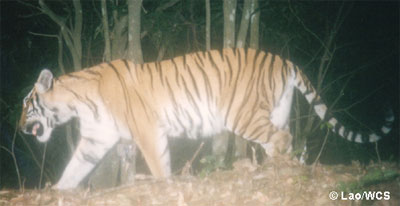 Camera trap picture of an Indochinese Tiger (Panthera tigris corbetti) in Nam Et and Phou Louey National Protected Area. Courtesy of WCS. |
Every year tens of millions of wild birds, mammals, and reptiles are killed to supply multi-billion dollar markets in China, the United States, and Europe. A still greater number are taken for local and domestic markets.
The reasons for the rise of commercial hunting are not complex—growing affluence among consumers, an increase in international trade, the emergence of increasingly sophisticated smuggling networks, an influx in weapons and technology, and easier access to wilderness areas facilitated by extractive industries all drive overexploitation of wildlife. But addressing the trade in a fair, yet effective, manner is challenging.
Wildlife depletion in Laos
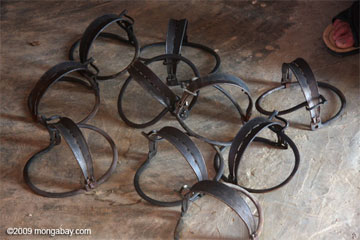 Snares confiscated in NEPL |
By most measures, Laos ranks as a low-income country, yet its people are generally able to feed themselves due to abundant natural resources, including fish, game, and food and fodder for livestock. But times are changing: as Laos opens up its economy to export-driven industries, ostensibly to improve quality of life, the very resources upon which rural people depend are at risk. The cost may be far higher than most imagine.
Like other forest-dependent people, rural Lao have long relied on hunting to supplement their rice-dominated diet with protein. People used traditional weapons and traps—including deadfall traps, rope snares, and spring traps—to catch game, but the opening of the economy to international investment and trade in the mid-1980s created a market for wildlife, putting a price on the heads of virtually all animals ranging from river insects to frogs to tigers. This, combined with a flood of weapons supplied by the government to battle the Hmong insurgency along the Vietnamese border, gave hunters the incentive and the tools to convert Laos’ rich biodiversity into cash. Meanwhile the growing affluence of neighboring Thailand, Vietnam, and especially China has created a vast new market for wildlife products—one that neither Laos nor its neighbors are likely to sustain. The trade, much of which is illegal, is taking a heavy toll on wildlife, not just in Laos but around the world—Southeast Asia, the Russian Far East, Africa, and even North America.
Wealth—not poverty—drives the wildlife market
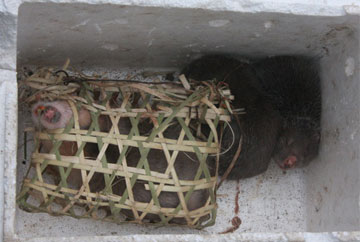 Live bamboo rats in the Luang Prabang morning market 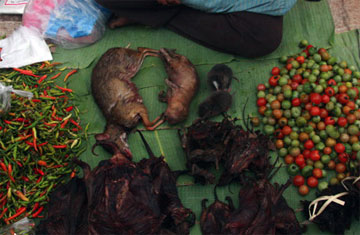 Bamboo rats and mouse deer in the Luang Prabang morning market |
Affluence, rather than poverty, is the strongest driver of the international wildlife trade. Rising incomes in China and Vietnam have buoyed demand for a wide range of wildlife products and pushed prices to the level where many species have become “too expensive to eat” for local people. Instead wildlife—dead and living—is sold to traders who traffic to urban markets and across international borders. A major source of demand is traditional Chinese medicine, which is based on the belief that the parts of certain animals have curative properties—river otter tails for labor pains, bear bile for fever, shark fins for cancer, rhino horn for fever, clouded leopard for “strength,” and python for fever and skin ailments. The tiger is the crown jewel. Its bones are used to treat rheumatism while the penis is soaked in wine and the wine drunk as an aphrodisiac. Prices for tiger carcasses have surged in Laos from less than $1,000 in the 1990s to more than $15,000 today, according to Arylne Johnson, co-director of the Wildlife Conservation Society’s Laos Program. In China the remains of a tiger may top $70,000.
Tigers in Laos, and across their range countries, also face a secondary threat—depletion of food sources. Unsustainable hunting is diminishing prey populations, making it difficult for tigers to survive in what would otherwise be suitable habitat and pushing them into conflict with humans. Hunters are taking full advantage of the development, using livestock to bait tigers; the loss of a cow is a small price to pay for catching a big cat. Sometimes a cow or a pig is slaughtered, dragged into the forest, and wired with snares or explosives. Other times a live animal is used. A tiger lured by an easy meal is converted into a pharmacological product.
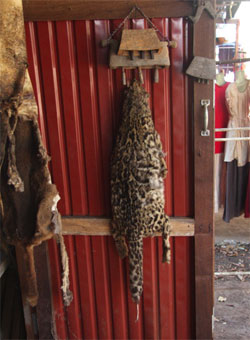 Marbled cat pelt in a market stall in southern Laos. |
Pangolins, believed to cure blood circulation problems and skin conditions, are also highly sought for the market. While commercial international trade in pangolins is banned under CITES (the Convention on International Trade in Endangered Species of Wild Fauna and Flora), the scaly anteater has been extinguished from much of Laos by poachers. Still, the extent of the pangolin trade in Southeast Asia remains enormous. TRAFFIC, a wildlife trade monitoring network, recently estimated that at least 100,000 pangolins—mostly sourced from Malaysia and Indonesia—are killed per year to meet Chinese demand. More than 25 tons of pangolin parts have been seized in Vietnam over just the past year alone, but the enforcement action demonstrated one of the major challenges facing those working to control the trade. Instead of destroying the pangolins, the contraband was auctioned off, thus allowing the wildlife products to reach their intended destination at the hands of the Vietnamese government rather than traffickers.
“Selling off the seized pangolins sent out entirely the wrong message,” said Sulma Warne, TRAFFIC’s Greater Mekong program coordinator, noting that while “it was permissible under Vietnamese law, it undermined the very enforcement efforts that led to the seizure.”
| Who are the buyers of wildlife products in local restaurants? “In Vientiane, wealthy older men (Lao and other Asian nationalities) seems to be the buyers in Lao restaurants,” said Johnson. “In French-style restaurants in Vientiane and Luang Prabang, the clientele are foreigners and tourists.” |
Mixed signals from the government are not unusual. A spate of reports from the Environmental Investigation Agency, TRAFFIC, and WildAid have cited complicity of authorities across Southeast Asia in the wildlife trade. Cross-border trade of large volumes of wildlife necessitates collaboration between traffickers and officials—border agents in Laos and Thailand are known to impose a “tax” on wildlife products, regardless of their origin or legality. Those who run the trade tend to be influential, often with ties to corrupt government officials or the military, and don’t limit themselves to wildlife: investigations have turned up links to other illicit trade, including weapons, drugs, and people. Further, consumers of high-value products are usually themselves wealthy relative to the general population. In fact, consumption of protected and endangered species in some cultures may confer status, a sense that the consumer is above the law.
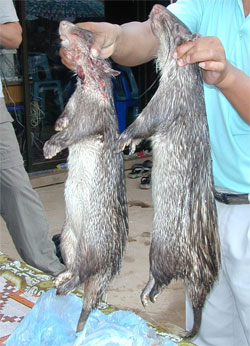 Brush-tailed porcupines sold in a Lao market |
Complacency may be even more common than complicity. Many countries have strong laws protecting wildlife but enforcement is weak. For example, traders caught selling in markets sometimes face only a scolding or seizure of contraband products. Where enforcement does occur, it sometimes serves only to drive the trade underground. In Laos, valuable wildlife products are dealt in private rather than public markets.
Politics also comes into play, especially in Laos. The reluctance of officials to enforce laws governing wildlife may stem from what some see as an inherent conflict between conservation and development. Thus, some charged with carrying out the law act with impunity. Forest rangers sometimes cite access to fresh meat as a chief benefit of a field assignment, according to Sarinda Singh, a University of Queensland researcher who conducted an assessment of wildlife trade in Laos. Relations between Vietnam and Laos also complicate enforcement, with authorities unwilling or unable to prosecute Vietnamese traders operating in the country.
“It seems that political patronage may be a key factor in the trade,” wrote Robert Nasi in a report on wildlife for the U.N. Convention on Biological Diversity.
A new source of income
|
Casual wildlife traders undersell the market, speeding depletion “In many cases the short term cash gain from selling wildlife is so attractive to local communities they don’t worry much about the long term loss of food resources,” said Troy Hansel of WCS-Laos, citing a recent example of a slow loris, a fully protected species, being sold for 5000 kip ($0.58) in a roadside village of Nam Et-Phou Louey. “A slow loris is a fully protected species so it is illegal to capture and eat this animal, let alone sell it. But had this animal been a managed species of the same body weight, would it be worth more to eat the animal than to get 5000 kip? In the same villages a chicken costs about 20,000 kip with only slightly larger body weight. So this tells me that these smaller less valued species are being sold at some discounted rate to what there are actually worth to a consumer in the village.” “This little bit of cash is not going to significantly improve one’s livelihood, but it is contributing to the continual decline of species in the village use areas—areas where villagers can hunt managed species for part of the year. This is particularly harsh on species with low fecundity rate, which are not able to keep up with the demand fueled by the illegal wildlife trade. These same species might be able to withstand a modest controlled harvest for consumption by local villagers living within that community.” |
In many parts of Southeast Asia wildlife is now as much a source of cash as it is of food. Depletion of rare species has only increased their value, encouraging hunting down to every last individual in some cases. The result: many areas now suffer from “empty forest syndrome,” where wildlife densities are too low to support people or predators like tigers. In fact depletion is so severe in parts of Laos that the country is as much as a smuggling route as it is a source of wildlife. Roads facilitate the trade.
The situation is particularly grim along the New Economic Corridor that links the heart of Laos to the world’s largest, and fastest growing, market for wildlife: China. The corridor, which includes an all-weather road and other infrastructure, has spurred widespread deforestation and wildlife poaching. Vast tracts of forest along the corridor have been logged for timber and converted for teak or rubber plantations, while hillsides have been burned for sticky rice cultivation. The money comes from Chinese business owners who not only provide finance but sell snares and traps, and place orders for fresh wildlife, guaranteeing a market for hunters and smugglers. The situation deteriorated to such an extent that in 2005 the Wildlife Conservation Society pulled out of its project in Nam Ha National Protected Area, the second largest nature reserve in the country at the time. Wildlife is commonly sold along the corridor, especially near the Chinese border.
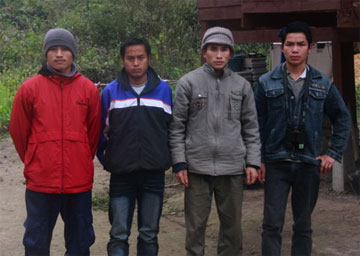 Local rangers employed by WCS |
In eastern Laos, many new roads are being largely financed by the Vietnamese. These roads are intended to facilitate access to Laos’ resources; wildlife comes as a bonus. In Laos, like other countries, there is a strong synergism between road-building and the wildlife trade. Loggers supplement their income with hunting and use logging trucks to transport bushmeat to traders and urban markets. Extractive industries like logging and mining also actively encourage human settlement, boosting demand for game as a source of protein. Cash-rich workers can afford to buy weapons, snares, headlamps, and outboard motors to speed wildlife depletion, especially in regions where arms are widely available from previous conflicts. A study published in the journal Conservation Letters in 2009 found pervasiveness of firearms to be a key contributing factor to that country’s precipitous drop in wildlife as hunters scaled activities to meet demand for external markets.
The costs of depletion
 Songbirds in the Luang Prabang morning market |
While the bulk of the proceeds from the wildlife trade accrue further up the supply chain to traders and smugglers, hunting has become a significant source of cash in some communities, albeit one that only lasts until wildlife is depleted. When overhunting is accompanied by forest loss, cash-poor populations may find themselves having to pay for services that were once free.
More subtly, “defaunation” has ecological ramifications, including disrupting the natural balance of wildlife populations and potentially impacting ecosystem dynamics through the removal of key pollinators, seed predators, and dispersers. These may have implications for human health—the outbreak of SARS, avian influenza, ebola, and other diseases have been linked to the wildlife trade.
Finding solutions
|
The impact of the pet trade The wildlife trade in Laos extends beyond demand for meat and medicinal products—the international pet market also plays a part. “Herps”, as reptiles and amphibians are known, are most commonly targeted, although young primates (gibbons, languars, and macaques) as well as selected species of birds are also taken. |
Addressing the wildlife trade means attacking on two fronts: supply and demand. International trade has changed the nature of the wildlife business, converting what was once a local food market into a lucrative commercial industry, with devastating consequences for wildlife. As such, reducing demand for wildlife products in consuming countries is a critical component to this effort. Organizations like WildAid and TRAFFIC run public awareness campaigns using bold advertisements warning consumers of the consequences—legal and ecological—of their consumption. While China is the most conspicuous target for such campaigns, Western countries are also major markets for products derived from wild animals. The United States and Europe rank among the largest buyers of elephant ivory, tiger parts, and even monkey meat. The United States has long been a destination for wildlife—in the 1950s Wanamaker department stores in Philadelphia and New York sold wildcats, orangutans, and chimps—and both America and Europe continue to be the leading buyers of exotic birds, fish, reptiles, and amphibians, many of which are poached from the wild. American diplomats and tourists support the trade when they buy furs and skins, often from endangered species, overseas. Even TV shows play a part—the Travel Channel’s Bizarre Foods program promotes wildlife consumption as a form of entertainment.
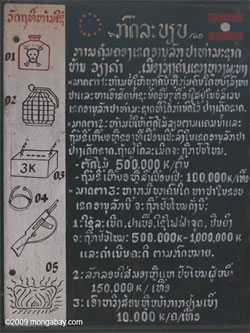 Sign showing prohibited hunting weapons 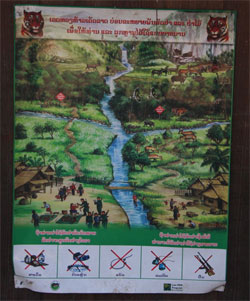 Conservation sign. |
“Wildlife trade won’t end until people stop buying,” Troy Hansel, who works on wildlife trade monitoring and human-wildlife conflict for WCS-Laos, said.
The supply side is more complex, complicated both by the reality that protecting a species under international law simply makes its killing more profitable, and that trade restrictions eliminate a source of income for the rural poor. In Laos, WCS is taking a multi-pronged approach to dealing with the wildlife trade. In addition to working with the government to clarify regulations—including a new wildlife law adopted last year—and strengthen enforcement through training of wildlife authorities and customs agents, WCS has established a comprehensive outreach program in local communities to explain what animals can be legally hunted and emphasize the consequences of wildlife depletion. The program includes registration of firearms, an informant network funded through fine collection, and a system of forest stations from which rangers launch patrols into core protected areas. WCS also works in urban areas where consumption and trade occurs.
Still, beyond enforcement and education, WCS’s Johnson and Hansel believe it is absolutely critical to prove to the Lao people that wildlife is valuable as a living entity. The conservationists are hopeful that carefully managed ecotourism which rewards local communities living in and around Nam Et-Phou Louey can create a strong link between wildlife protection and local well-being. More broadly, Johnson and Hansel are working to demonstrate that conservation is in the interest of local people. Their model seems to be paying off so far. In parts of Nam Et-Phou Louey where it has conducted its outreach project and has a strong presence, WCS has seen changes in wildlife behavior that indicate less hunting pressure.
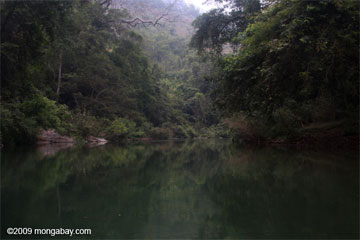 Nam Nern River |
“We are seeing birds in villages and wildlife along rivers,” Hansel said. “Civets are no longer showing the fear they did just a few years ago.”
A short foray into the park showed hopeful signs. I spotted owls, civets, a pair of otters, and an East Asian porcupine during a single evening boat trip up the Nam Nern river in Nam Et-Phou Louey. Tiger tracks were seen by rangers the day before.
WCS Laos Program